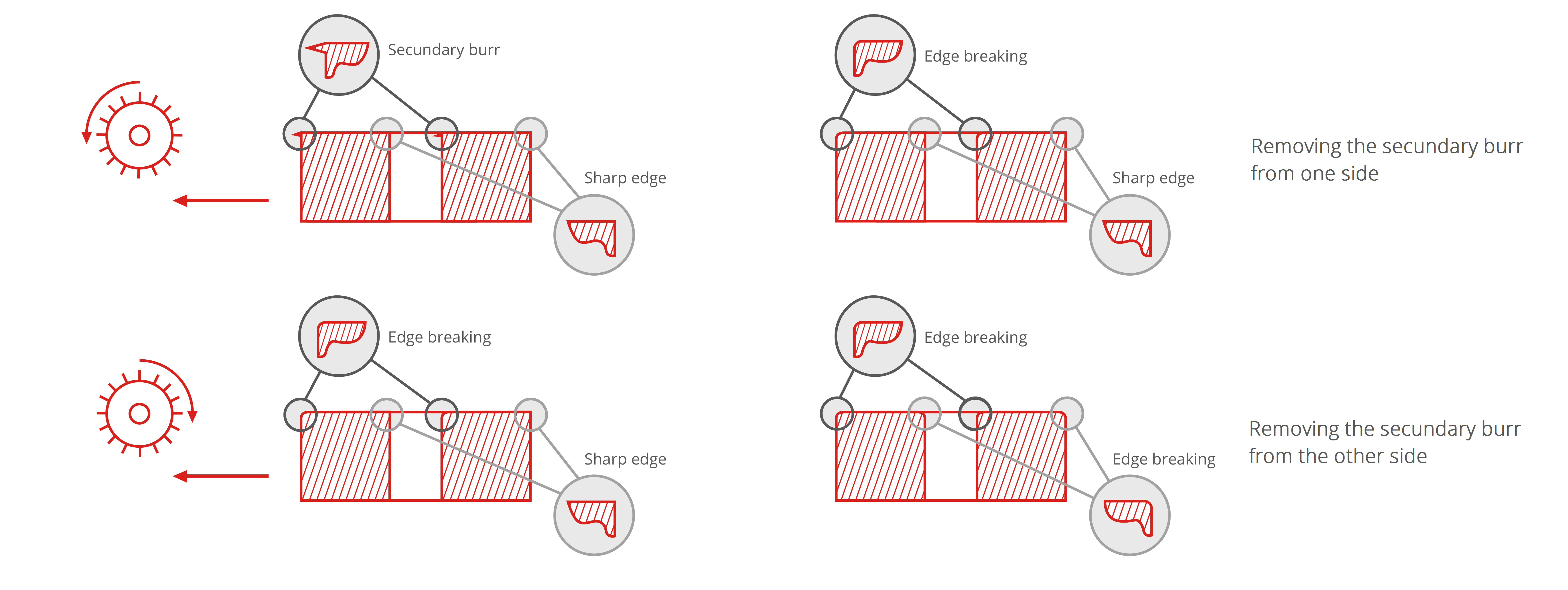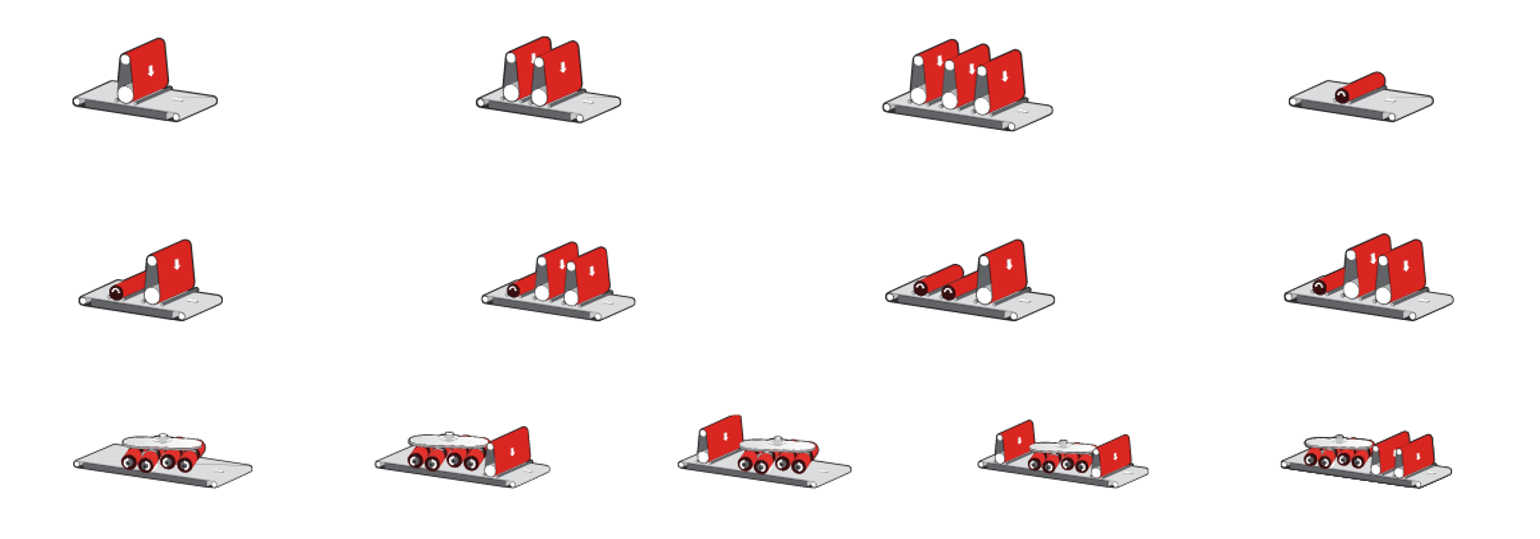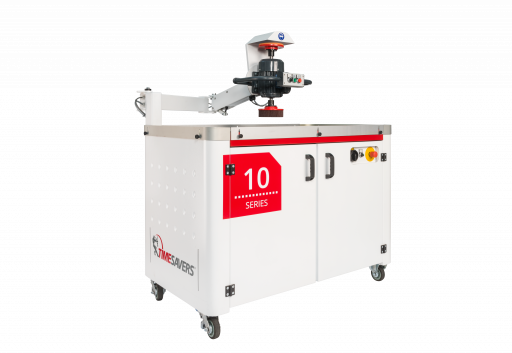Burrs are ridges, or raised or sharp edges on metal that causes the workpiece to be uneven, and are often created during cold machining operations, such as punching, drilling, milling, cutting or turning.
Another form of burr is metal that has been fused to a component due to hot machining operations, for instance casting, forging and laser or plasma cutting. These burrs on the workpiece are unsightly and reduce the functionality as well as the safety of each affected part. Therefore, not only from an aesthetic point of view but also for safety and assembly reasons, it is needed to remove burrs, which is called: deburring.
How is deburring done?
There are several ways to deburr a metal workpiece.
Manual deburring; in which the burrs are scraped off by using manual deburring tools. Although it is an economical method carried out by experienced craftsmen, it is time and labor intensive and leaves the products with inconsistent quality. This is becoming more and more a thing of the past.
Mechanical deburring; in which machines grind off the burrs and therefore it can be done at high speed, with a consistent, high quality of products. The burr removal machines can work through a wet or dry process.
Thermal deburring; in which heat energy is used to scald out the burrs. It involves a mixture of gases that lead to a chemical reaction when there is an excess of oxygen. This reaction vaporizes the burr.
Electrochemical deburring; which uses anodic metal dissolution in order to deburr, without damaging the surrounding metal, and finish the workpiece. An electrolyte fluid is used in this process.
Cryogenic deburring; which freezes and removes the machine burrs by non- abrasive polycarbonate media.
Tumbling; which uses a barrel with abrasives and liquids that, due to the centrifugal force, rub against the metal parts. These centrifugal deburring machines remove the burrs and leave the product with a surface finish. Therefore, this method can be used as a centrifugal finishing machine as well.
How does mechanical deburring take place?
In order to speed up the process of deburring, without the products losing their quality, Timesavers is offering a variety of deburring machines. Now, what does such machinery do?
First of all, a deburr machine automizes the deburring process. Owing to the abrasive belts that are available in different grain sizes, the burrs can be smoothed out of the metal. The grain size depends on the type of metal that needs to be deburred. A finer type of grain has opted for a softer alloy.
Furthermore, the preceding production process of the metal parts, determines what deburring method needs to be used, while laser processing leaves harder burrs behind than punching, and a plasma cutter produces much larger burrs. These larger burrs that are created during plasma cutting, can be removed with the use of the hammerhead configuration.
Although the abrasive belts remove the initial burrs, it creates almost always a smaller, secondary burr, mainly in sanding operations performed in the horizontal plane, as is clearly shown in the image above. Therefore, additional brushes can be used to make it an edge deburring machine that removes the burr on one side and breaks the edge. This leaves the metal part with only one sharp edge that can be broken with a brush that turns the other way around.
This process can be applied to different sorts of metals, like aluminium, stainless steel, titanium, molybdenum, zirconium, copper, zinc-coated or foiled products and so on. When using the machine for different metals, it is a must that the dust extractor is connected, in order to avoid sparks caused by the metal dust within the machine. This is also one of the reasons that table cleaning is installed for automatic cleaning on a regular basis.
Advantages of mechanical deburring
- The workpieces become more appealing and look professional.
- It contributes to the functionality and durability of the metal component.
- The parts are of consistent quality because of the automation, so that rework becomes unnecessary.
- It saves time, labour and costs, thus leading to higher productivity.
- It ensures a flexible way of working, considering the machine can easily be adjusted to each type of product.
- Both the deburring process as the deburred parts, become safer for the personnel and reduce the risk of injuries.
- Multiple machining processes can be carried out in a single pass. These are mentioned in the following paragraph.
Timesavers deburring machine
Most importantly, Timesavers offers the right solution to your deburring problem, whether you have small parts or bigger ones, much or little space, a high or low budget. We at Timesavers will help you find the right machine that meets your wishes. The machines are easy to use and will decrease your process times, hence increasing your company output.
In addition, Timesavers has also got different configurations that can include edge rounding, laser oxide removal and finishing. Some of the configurations can be found below.
Deburring and edge rounding machines can be combined when it is desired to break the edges by using a brush or even get a certain radius by using the rotative brushes, in addition to deburring. A radius of 2 mm is in certain industries a requirement, for example, the food industry or pharmacy.
Another reason for round edges to be required is so that the paint or coating fully adheres. These rotative brushes can also be partially replaced by laser oxide removal brushes.
When a roller is added at the end of the machine, it makes it possible to combine the process of deburring and polishing in one pass, thus leaving you with deburred products with a quality finish. Timesavers offers different finishing systems with each its own result. Non-woven material is used in the finishing process, such as the Scotch-Brite belt, which has an embedded grain fibre, which makes it flexible and therefore able to follow the shape of the workpiece. It results in a very fine and consistent surface finish.
Additionally, Timesavers has trained service technicians that provide service and maintenance on Timesavers’ machines all over the world and our worldwide dealer network also provides service in the country in which they are located. Moreover, your operators will be given training by our service engineers, after the installation of your new machine. The knowledge and skills that are taught to your personnel, will help you to get the perfect result from our machines.
Timesavers also provide the original spare parts and tooling, so you will be assured that the machine is properly functioning. It is always possible to contact us whenever you have questions.
About deburring
+
What is deburring?
In short, deburring is the process of removing burrs, irregularities and sharp pieces from metal, with the use of an abrasive tool. Deburring leaves the product with a smooth surface. Read here more about deburring
+
Why do you need to deburr?
Deburring metal parts adds to the aesthetics and it also reduces the risk of injuries to employees. With the use of abrasive grinding belts, there will be no more irregularities and no more sharp residuals. Read more about why you should deburr and round the edges of metal parts.
+
Why is it important to remove the burr of metal parts?
Burrs need to be removed to improve the safety during handling and assembly. Read more about why you should deburr and edge round metal parts.
+
What size of parts can be deburred?
Small metal parts of already 50 x 50 mm can be deburred by a machine, because of a vacuum table or magnetic track that holds them in place. Large parts that can be processed are up to a 1600 mm width with a Timesavers deburring machine. Here you find an overview of all the product that can be processed on our machines.
+
How to remove burrs from metal?
In order to effectively and efficiently remove burrs, it is recommended to use a deburring machine for consistent results. With such machine, the burrs are grinded off the products with abrasive material. Here you can check which deburring machine suits you best.






